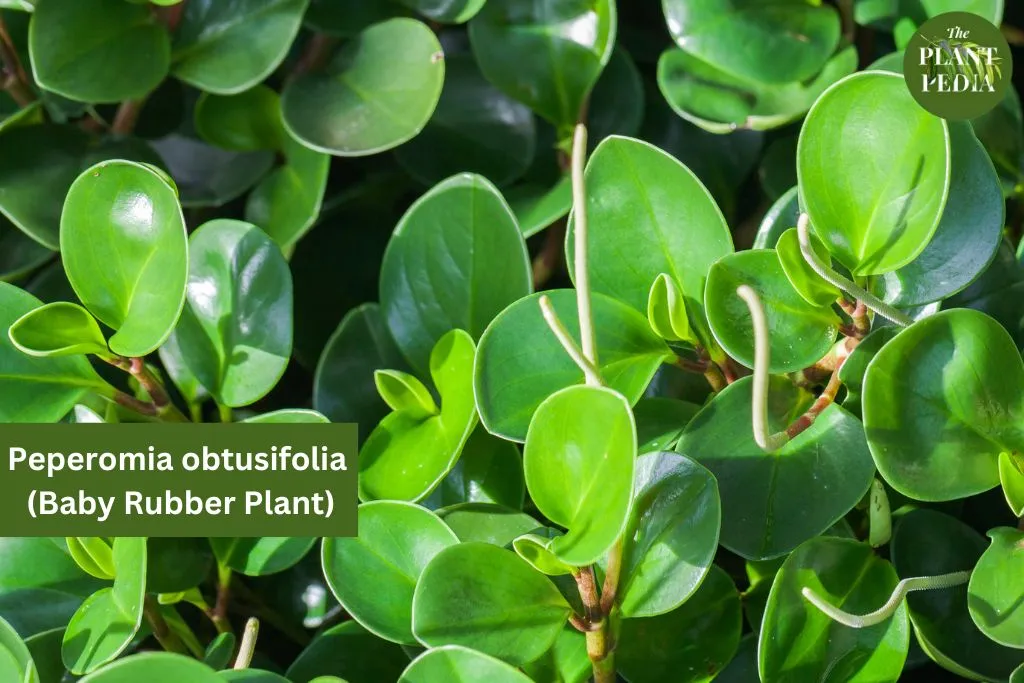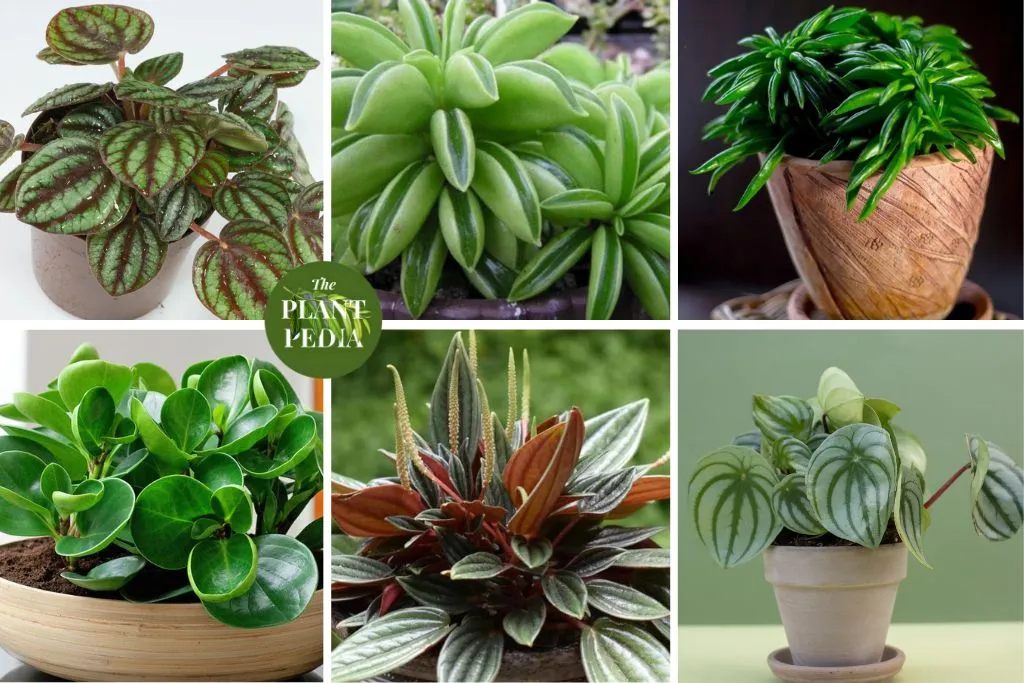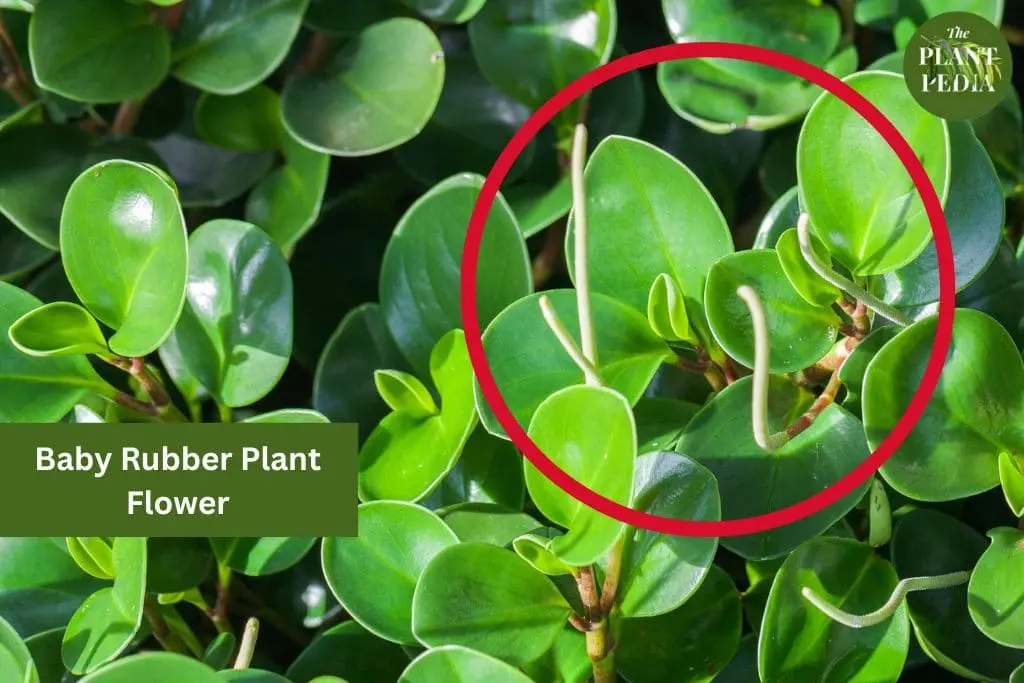In the vast tapestry of botanical wonders, few plants manage to captivate our attention quite like the Peperomia obtusifolia.
This unassuming yet enchanting plant, known for its lush foliage, often surprises enthusiasts with its delicate and intricate flowers.
In this in-depth exploration, we delve into the captivating world of the Peperomia obtusifolia flower, uncovering its origin, characteristics, lifecycle, and the art of its care.
The Origins of Peperomia Obtusifolia:
The Peperomia obtusifolia, commonly known as the “Baby Rubber Plant” or “American Rubber Plant,” is a member of the Peperomia genus, which belongs to the Piperaceae family.
This family includes a wide range of plants, including the well-known black pepper (Piper nigrum).
Peperomia obtusifolia is native to parts of Central and South America, where it can be found growing in tropical and subtropical regions.
Let’s delve deeper into the origins of the Peperomia obtusifolia:
Native Range:
Peperomia obtusifolia is native to several countries in Central and South America, including:
- Mexico
- Caribbean islands
- Venezuela
- Colombia
- Ecuador
- Peru
- Brazil
Its natural habitat spans diverse environments such as rainforests, tropical forests, and shaded areas with consistent moisture.
These regions provide insight into the plant’s preferred growing conditions, which can guide its care as a cultivated houseplant.
Habitat and Growth Conditions:
In its native habitat, Peperomia obtusifolia often grows as an epiphyte or a terrestrial plant. Epiphytes are plants that grow on other plants, using them as support, but not as a source of nutrients.
This adaptation allows the plant to access more light and better airflow in its forested surroundings.
The tropical and subtropical climates of its native range provide the warm temperatures and high humidity that Peperomia obtusifolia thrives in.
These conditions influence its preference for bright, indirect light, moderate humidity, and stable temperatures when cultivated as a houseplant.
Cultural Significance:
While Peperomia obtusifolia might not have a strong cultural or historical significance like some other plants, it has gained popularity as a beloved houseplant in various parts of the world.
Its attractive foliage, low-maintenance care requirements, and adaptability to indoor environments have made it a favorite among plant enthusiasts and interior decorators alike.

Read: Baby Rubber Plant Care: Tips and Techniques.
Varieties and Cultivars:
Over time, horticulturists have developed various cultivars of Peperomia obtusifolia with unique leaf patterns, colors, and sizes.
Some popular cultivars include ‘Variegata,’ which features variegated leaves with creamy edges, and ‘Alba,’ which has all-green foliage.

Read: 60 Peperomia Varieties (Types of Radiator Plant) For Indoor.

Anatomy of the Peperomia Obtusifolia Flower:
The Peperomia obtusifolia flower may be small and unassuming, but its anatomy reveals a world of intricate structures and fascinating adaptations.
To truly appreciate the beauty within its modest petals, let’s take a closer look at the various components that make up this delicate bloom:
1. Inflorescence:
The inflorescence is the cluster or arrangement of flowers on the stem. In the case of Peperomia obtusifolia, the flowers are arranged in dense, cylindrical or conical spikes.
This unique arrangement maximizes the plant’s chances of successful pollination, as it increases the visibility of the flowers to potential pollinators.
2. Bracts:
Bracts are modified leaves that accompany and protect the flowers. In the Peperomia obtusifolia flower, these bracts can vary in color and texture.
While they might not initially catch the eye, they play a vital role in supporting and shielding the delicate flowers as they develop.
3. Sepals:
Sepals are small, often green, leaf-like structures that encase the flower bud before it fully opens.
In the Peperomia obtusifolia flower, sepals provide protection to the developing petals and reproductive structures within the bud.
4. Petals:
While the petals of the Peperomia obtusifolia flower are not large or showy like those of more flamboyant blooms, they possess their own delicate charm.
The petals can be greenish-white, pale yellow, or even translucent, blending subtly with the surrounding foliage.
In some species, the petals might be reduced in size or absent altogether, emphasizing the plant’s focus on other means of reproduction, such as asexual propagation through its leaves.
5. Stamens:
Stamens are the male reproductive organs of a flower, consisting of the filament and anther. The anther produces pollen, which contains the plant’s male genetic material.
In the Peperomia obtusifolia flower, the stamens release pollen, which can be transported by wind, insects, or water to other flowers for fertilization.
6. Pistils:
Pistils are the female reproductive organs of a flower, consisting of the stigma, style, and ovary. The stigma is the receptive surface for pollen, where fertilization begins.
The style serves as a bridge between the stigma and the ovary, allowing the pollen to travel down to the ovary where fertilization takes place.
The ovary contains ovules, which develop into seeds after fertilization.
7. Pollination Mechanisms:
The Peperomia obtusifolia flower employs various mechanisms for pollination. In their native habitats, wind, insects, and even water can play a role in transferring pollen between flowers.
The subtle fragrances and nectar, though often not noticeable to humans, may attract insects like gnats, which can inadvertently aid in pollination as they move from flower to flower.
8. Seed Development:
Once fertilization occurs, the ovary of the Peperomia obtusifolia flower swells as the seeds develop. The ovary walls might change in texture and appearance, resembling a fruit-like structure.
Inside this structure, small seeds form, each containing the genetic information needed for new plant growth.
Life Cycle of the Peperomia Obtusifolia Flower:
The lifecycle of the Peperomia obtusifolia flower is a captivating journey that mirrors the intricate beauty of the plant itself.
It follows a generalized angiosperm life cycle, involving pollination, fertilization, and seed production.
- Pollination: In their native habitats, Peperomia obtusifolia flowers are pollinated by various means, including wind, insects, and even water. The inconspicuous flowers release pollen, which is carried to other flowers for fertilization.
- Fertilization: Once the pollen reaches a compatible flower’s stigma, it travels down the style to the ovary, where fertilization occurs. The fertilized ovules develop into seeds.
- Seed Production: The ovary swells as the seeds develop. Once mature, the ovary walls often transform to create a fruit-like structure. Inside this structure, small seeds form, containing the genetic information needed for new plant growth.
Caring for Peperomia Obtusifolia to Encourage Flowering:
Caring for your Peperomia obtusifolia properly can greatly encourage flowering and promote overall plant health.
While the flowers of Peperomia obtusifolia might not be as showy as those of other plants, they add a special touch of beauty to this already charming plant.
Here’s a comprehensive guide to caring for your Peperomia obtusifolia to encourage healthy growth and potential flowering:
1. Light:
Peperomia obtusifolia thrives in bright, indirect light. While it can tolerate some low light conditions, placing it in moderate to bright indirect light will encourage better growth and potential flowering.
Avoid direct sunlight, as it can scorch the leaves and hinder flowering.
Read details: Peperomia Obtusifolia Light Requirements: A to Z Guidelines.
2. Temperature:
Maintain a consistent temperature between 65-75°F (18-24°C) to mimic the plant’s native habitat.
Avoid exposing the plant to temperature extremes or drafts, as they can stress the plant and affect its growth.
3. Humidity:
Peperomia obtusifolia appreciates moderate humidity levels. If you’re in a dry climate or your indoor environment is too dry, consider using a humidity tray, a room humidifier, or occasionally misting the plant to maintain adequate humidity around the foliage.
4. Watering:
Water your Peperomia obtusifolia moderately, allowing the top inch of the soil to dry out between waterings.
It’s better to slightly underwater than overwater, as the plant is susceptible to root rot. Water less frequently during the plant’s dormant period in the winter.
5. Soil:
Use a well-draining potting mix that’s suitable for houseplants. A mixture containing peat moss, perlite, and other organic materials is ideal for Peperomia obtusifolia. Good drainage prevents waterlogged roots.
6. Fertilization:
During the growing season, which typically spans from spring to early fall, feed your Peperomia obtusifolia with a balanced, diluted liquid fertilizer every 4-6 weeks.
Avoid over-fertilizing, as this can lead to excessive foliage growth at the expense of flowering.
7. Pruning:
Regularly remove dead or yellowing leaves to keep your plant looking tidy and to encourage healthy new growth. Pruning can also help divert the plant’s energy towards potential flower production.
8. Potting:
Repot your Peperomia obtusifolia when it becomes root-bound or when the soil begins to break down and lose its ability to drain well.
Repotting every 1-2 years in a slightly larger pot will provide the plant with fresh soil and room for growth.
9. Pest Control:
Monitor your plant for pests like spider mites, aphids, and mealybugs. Regularly inspect the leaves, both the top and underside, and treat any infestations promptly to prevent damage that could inhibit flowering.
10. Dormancy:
Peperomia obtusifolia often goes through a period of dormancy during the winter months, during which its growth may slow down.
During this time, reduce watering and avoid fertilization to allow the plant to rest.
11. Patience:
While you can provide the ideal conditions for your Peperomia obtusifolia, remember that flowering might not always occur.
The flowers are often subtle and can be influenced by factors beyond your control, such as the plant’s age and genetics.
By following these care guidelines and giving your Peperomia obtusifolia the attention it needs, you’ll not only encourage potential flowering but also cultivate a healthy and vibrant plant that will continue to bring joy with its lush foliage and occasional delicate blooms.
Symbolism and Cultural Significance:
While the Peperomia obtusifolia flower might not be steeped in historical or cultural symbolism like some more iconic blooms, its unassuming nature and hidden beauty offer lessons and connections that resonate with broader themes.
Here’s a closer look at the symbolism and cultural significance that the Peperomia obtusifolia flower might embody:
1. Modesty and Subtlety:
The Peperomia obtusifolia flower’s modest appearance serves as a reminder that beauty can be found in the simplest and most unassuming aspects of life.
In a world where grandeur often takes center stage, this unpretentious bloom symbolizes the value of humility and the notion that genuine beauty doesn’t always need to be bold and ostentatious.
2. Hidden Beauty:
The Peperomia obtusifolia flower’s delicate nature and small size teach us to appreciate the beauty that lies beneath the surface.
Just as we might overlook the intricate details of everyday life, this flower invites us to slow down and take a closer look at the world around us, unveiling the hidden treasures that might otherwise go unnoticed.
3. Resilience and Adaptation:
The Peperomia obtusifolia plant, including its flowers, has adapted to thrive in diverse environments. This resilience can be a symbol of our ability to adapt to challenges and find beauty even in adverse conditions.
It serves as a reminder that growth often requires flexibility and the willingness to embrace change.
4. Nurturing and Care:
Cultivating a Peperomia obtusifolia and encouraging its delicate flowers to bloom requires attention, care, and patience.
In this sense, the plant can symbolize the nurturing relationships we build with nature and with one another. Just as we care for the plant, we also care for our connections, allowing them to flourish and grow over time.
5. Inner Beauty:
The Peperomia obtusifolia flower might not have the vibrancy of more flamboyant blooms, but it embodies the concept of inner beauty.
Like the saying “it’s what’s on the inside that counts,” this flower reminds us that true beauty goes beyond appearances and lies in the essence of the being or object itself.
6. Cyclical Nature of Life:
The Peperomia obtusifolia flower’s lifecycle mirrors the broader cycles of life, from pollination and fertilization to seed production.
This cyclical nature can symbolize the ebb and flow of life, growth, and renewal, suggesting that even the smallest elements of nature play a part in the larger rhythm of existence.
7. A Connection to Nature:
Growing and tending to plants like Peperomia obtusifolia can deepen our connection to the natural world.
The plant’s unobtrusive beauty encourages us to embrace the tranquility of nature and find solace in its simple, often overlooked wonders.
In cultures where the Peperomia obtusifolia is cultivated, it might carry local significance tied to folklore or traditional beliefs.
However, its global symbolism primarily revolves around the universal themes of modesty, hidden beauty, and our relationship with the natural world.
As you care for your Peperomia obtusifolia and admire its unassuming flowers, consider the deeper meanings it holds and the lessons it imparts about embracing simplicity and finding beauty in the everyday.
Related FAQs:
Do all Peperomia obtusifolia plants flower?
Not all Peperomia obtusifolia plants will flower, and even when they do, the flowers are often small and inconspicuous.
Factors such as the plant’s age, growing conditions, and genetics can influence its likelihood to produce flowers.
How often do Peperomia obtusifolia plants flower?
Peperomia obtusifolia plants typically flower during their growing season, which is usually in the warmer months of spring and summer.
However, the frequency of flowering can vary. Some plants might produce flowers annually, while others might only do so sporadically.
What do Peperomia obtusifolia flowers look like?
Peperomia obtusifolia flowers are small and unobtrusive. They are often greenish-white, pale yellow, or even translucent.
The flowers are arranged in dense spikes on upright stems called inflorescences. While not showy, their delicate appearance adds a unique charm to the plant.
How can I encourage my Peperomia obtusifolia to flower?
To encourage flowering, provide your Peperomia obtusifolia with bright, indirect light, moderate humidity, and consistent temperatures between 65-75°F (18-24°C).
Avoid over-fertilization, and ensure proper watering practices, allowing the top inch of soil to dry out before watering again. Prune to remove dead leaves and promote healthy growth.
Do Peperomia obtusifolia flowers have a fragrance?
Peperomia obtusifolia flowers often have a subtle fragrance that might not be noticeable to humans. The fragrances can attract small insects like gnats, which can inadvertently aid in pollination.
Can I propagate Peperomia obtusifolia from its flowers?
While Peperomia obtusifolia can be propagated through leaf cuttings or stem cuttings, propagating from its flowers is not a common method.
The primary propagation methods involve taking healthy leaf cuttings with a node and allowing them to root in a suitable growing medium.
How long do Peperomia obtusifolia flowers last?
Peperomia obtusifolia flowers typically have a relatively short lifespan, often lasting a few weeks to a couple of months.
Their duration can depend on factors like environmental conditions and the health of the plant.
Are Peperomia obtusifolia flowers toxic to pets?
Peperomia obtusifolia plants, including their flowers, are considered non-toxic to cats, dogs, and humans.
However, it’s always a good practice to keep plants out of reach of pets and children to prevent unintended consumption.
Can I deadhead Peperomia obtusifolia flowers to promote more blooms?
Deadheading, or the removal of spent flowers, is not a common practice for Peperomia obtusifolia. Unlike some other plants, deadheading might not significantly impact the plant’s flowering cycle.
Instead, focus on overall care and maintenance to encourage healthy growth and potential flowering.
Are there different varieties of Peperomia obtusifolia with distinct flowers?
Yes, there are various cultivars and varieties of Peperomia obtusifolia, each with its own unique foliage patterns and characteristics.
While the flower structure remains relatively consistent, there might be subtle variations in flower color and size among different cultivars.
Conclusion
The Peperomia obtusifolia flower, though often overshadowed by its lush foliage, stands as a testament to the intricate marvels that nature has to offer.
Its unassuming appearance and captivating lifecycle teach us to appreciate the nuances of the botanical world.
From its origin in the diverse landscapes of Central and South America to its intricate anatomy and modest yet charming flowers, the Peperomia obtusifolia flower invites us to explore the depths of its beauty and the secrets it holds within its unpretentious petals.
So, the next time you encounter a Peperomia obtusifolia, take a moment to marvel at the hidden masterpiece that is its flower, and consider the profound stories that even the smallest elements of nature have to tell.
